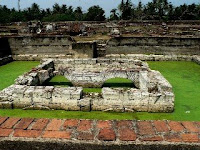
(PART – 3)
2.5 km from Tasik Ardi artificial lake, we entered the Old Banten city area. Across the bridge over the canal (oh, this is the canal that used to be sailed by small boats age century ago, I thought). Just passed by the bridge, crossing the crowded of people and public transportation, on our left side there was the ruin of Surosowan fortress! Inside of the fortress, here there was the palace been standing! Wow, so, this is the only left of the famous Sultan Ageng Tirtayasa’s palace!? It was the about 3 acres area which surrounded by fortress at about 2 meters in height.
With the hot sunshine, I and my wife walked around the ruin of surosowan palace inside the fortress. Thanks God, my wife didn’t forget to bring an umbrella. It was very hot day.
This palace is built in several steps between years 1522 until 1570. The palace is largely ruined, however the beautiful of the palace still could be imagined when we see the remained buildings inside of the fortress. They are the rounded gate of royal palace, royal pool “Roro Denok”, which was built for the princess bathing, completed with the Bale Kambang (it is like gazebo, placed in the garden pond, usually used for take a rest) in the middle of the pool, 3 royal stairs made a half circle from terracotta and Pancuran Mas (Golden faucet/fountain) in the back which water from Tasikardi came into the palace beside the plumbing system around the palace.
In its time the palace was surrounded by watery canals that connected to the
Firstly, Surosowan palace was built by sultan Maulana Hasanudin (the first sultan of Banten) in 1552 – 1570. Then, sultan Maulana Yusuf (the second sultan of Banten), built the gate surrounding the palace. The palace gate was made from red brick stone and corals. Surround the gate was dig to make a ditch and also built princess royal pool inside the palace. In the time that sultan Ageng Tirtayasa (the fourth sultan of Banten) ruled the kingdom, he hired Dutch architect Hendrik Lucaszoon Cardeel to strengthen the gate by additional of Bastions at each corner of the gate.
When you came to Surosowan palace, don’t imagine that you will find a complete building like Borobudur temple or other historical building in
Out from the enter gate of the fortress, in the north about 50 meters (It supposed to be city square in the past) we could found the flat stone which called “Watu Gilang Sriman Sriwacana”. This stone was belong to
We could also find the almost the same stone nearest, in the east of the great mosque. This stone was called “Watu Singayaksa” where along time ago was used to announce the sultan’s order or sultan’s regulation.
To gain more information about
Actually it is sadden, to see the condition of the old Banten city, one of the old archaeology sites in


.jpg)









1 comment:
bagus sob.. ngangkat sejarah di banten.. saya blum puny data buat nulisnya..
Post a Comment